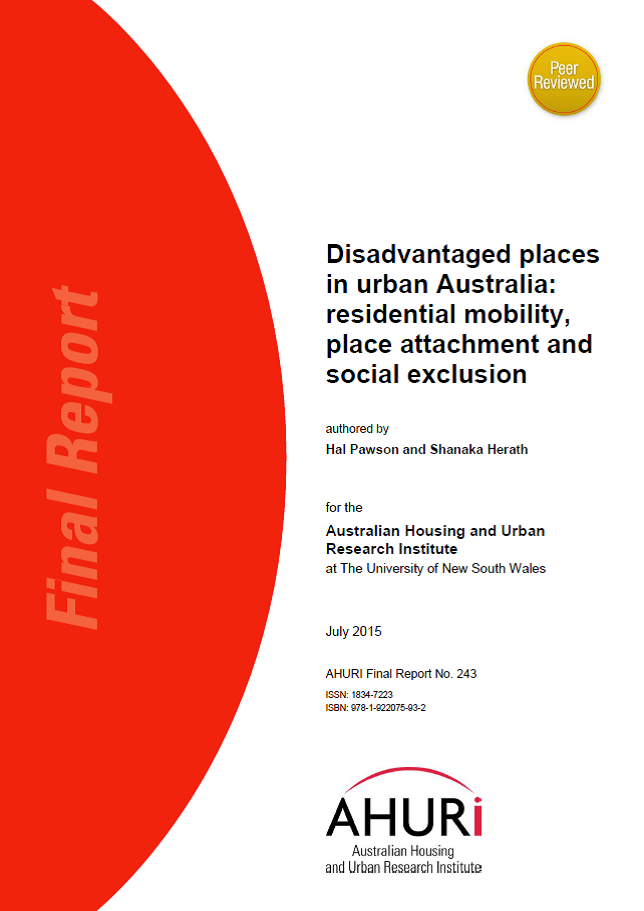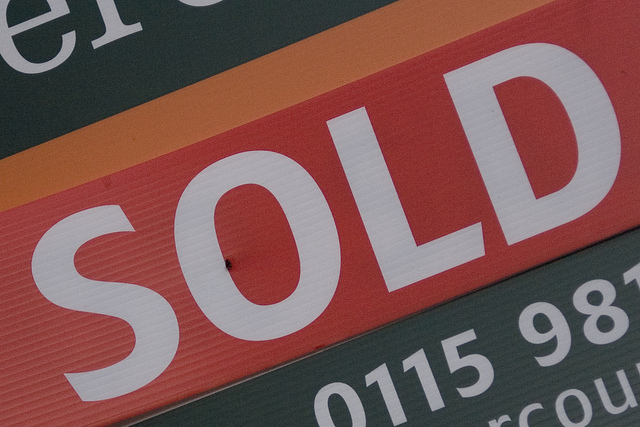Many residents of disadvantaged suburbs in our major cities rightly see their home locality as posing problems for themselves and their neighbours. Key concerns include exposure to relatively high rates of crime and antisocial behaviour (41% of people living in such areas believe that ‘crime is a problem here’), and remoteness from job-rich localities (only 33% endorse the statement ‘There are good employment opportunities within or accessible to the area’). Importantly, this latter factor contributes to typically high unemployment (and especially female unemployment) experienced in these places. With the geography of disadvantage in Australia’s major cities shifting ever further outwards, away from our job-rich inner urban areas, this is a growing problem. [Read more →]
Disadvantaged places in urban Australia: residential mobility, place attachment and social exclusion
Posted by Hal Pawson on July 23rd, 2015 · Uncategorized
What’s the problem with foreign ownership of Australian real estate?
Posted by Chris Martin on July 16th, 2015 · Affordability, Housing
When housing experts at City Futures and other Sydney unis put forward recently a national 10-point plan for housing affordability, there was a lot of interest and commentary… and a lot of the commentary was about foreigners buying Australian housing. Do we need an 11-point plan – or, as some commentators seem to suggest, a one-point plan – that bans or restricts non-permanent residents from owning Australian housing?
On the other hand, maybe we should be asking a different question: is there anything better suited to selling to foreigners than real estate? [Read more →]
Social Enterprises Can Help Drive Social, Economic Growth
Posted by Hal Pawson on July 13th, 2015 · Construction, Social enterprise
By Professor Martin Loosemore, Faculty of the Built Environment, UNSW

There is a new breed of Australian social entrepreneurs operating in the construction industry who are creating inspiring social enterprises which trade for a social and/or environmental purpose.
These social enterprises feed their profits back into the communities in which they operate rather than to private shareholders. Most are located in our most disadvantaged communities, providing employment opportunities for Australia’s most marginalised groups who are normally excluded from the workforce such as the indigenous, disabled, ex-offenders, long-term unemployed and other minority groups.
These social enterprises represent a largely untapped and innovative way for businesses operating in the construction industry to engage more effectively with the communities in which they build, providing potentially life-changing opportunities for the most vulnerable and disadvantaged in our society.
Many forward thinking public and private clients are recognising their crucial leadership role in encouraging this new ‘third economic sector.’ New Indigenous employment policies (such as the NSW Aboriginal Participation in Construction Policy) and social procurement guidelines being produced by state governments and major private clients with a social conscience are requiring firms tendering for new construction contracts to demonstrate some kind of social value in their bid in addition to complying with traditional tender criteria such as price, time, quality, safety and the environment.
Following similar trends in the US, UK and EU, where social procurement legislation is fast changing traditional procurement practices, it is almost certain that in the future Australian construction firms (and anyone in their supply chain) will also be required to compete on their social credentials, not just on price. This will mean that they will have to measurably demonstrate that they are contributing to the communities in which they build and that they don’t just deliver great new buildings and infrastructure, but that the process of constructing them also provides local jobs, training and other community benefits too.
However, while much of Australia’s construction industry is world-leading in successfully integrating environmental improvements into new projects, the vast majority of companies have much to learn in developing effective strategies to deliver and measurably demonstrate the social impact of business activity in the community. While a few leading firms are beginning to engage with social enterprises, recent research shows that most companies in construction lack the knowledge, experience and relationships to engage effectively.
None of these challenges, though, are insurmountable and government, major clients and the community are looking for someone to take a leadership role in this space.
The timing is perfect and a solution is badly needed.
Despite 23 years of continuous growth, more than 10 per cent of Australians still live in poverty and recent research shows that two million are trapped in a cycle of long term unemployment, economic inactivity or underemployment. Young people are especially vulnerable; 41.7 per cent from the poorest backgrounds are disengaged from work or study, more than double the 17.4 per cent in the most affluent group. Indigenous students fare by far the worst. In some areas of Australia over 60 per cent are not fully engaged in work or study.
In last month’s Federal budget, Treasurer Joe Hockey announced a $5.5 billion growth package aimed at stimulating grassroots innovation and enterprise throughout the Australian economy. The government is looking to rely on small business and entrepreneurs to reconfigure the Australian economy bottom-up, moving it away from resources and toward a new and sustainable growth trajectory. When considered alongside country’s planned infrastructure pipeline ($20 billion on the table in NSW – plus the Federal government’s $50 billion transport infrastructure roll out) we have a once in a lifetime opportunity to work with the government get more for our public money and leverage public spending to address growing social inequity and disadvantage in our society.
The Productivity Commission Report into Public Infrastructure limited its analysis to the economic and productivity benefits of the planned infrastructure pipeline. Yet we know that at its best, construction and infrastructure projects can have a transformative impact on local communities, regional economies and national prosperity. Construction projects come-and-go but communities stay.
After an unprecedented three Royal Commissions into the construction sector over the last 30 years, such a positive legacy would be some badly needed good news!
Martin Loosemore is Professor of Construction Management at UNSW. A prolific researcher, Martin has published over 200 scholarly books and internationally refereed articles in risk management, innovation, social enterprise, corporate social responsibility and HRM. His most recent work on social enterprise and corporate social responsibility explores how private firms can engage more effectively with communities.
This post was first published at Sourceable.net on 2 June 2015
For a recently published City Futures Research Centre report on social enterprise in the realm of community housing see: Strategies of Australia’s Leading Not-for-profit Housing Providers: A national study and international comparison
A New Metropolitan Consciousness: Towards a Resilient Sydney
Posted by Hal Pawson on July 9th, 2015 · Wellbeing
By Greg Paine, City Wellbeing Program, City Futures Research Centre

City Futures attended the recent workshop held by the City of Sydney as the first stage in establishing a program for a “resilient Sydney” as part of the Rockefeller Foundation’s $100 million 100 Resilient Cities program – which is to assist 100 cities world-wide to build capacity to withstand and recover from future potential shocks. The program addresses the increasing pressures being placed on existing systems by rapid urbanisation and globalisation coupled with the impacts of climate change. Combined, it means that any one shock to those systems will be magnified, with critical flow-on impacts not just to the particular city and its region but now also globally. Sydney joins Melbourne as the only Australian cities in the program. [Read more →]
Renewing the Compact City
Posted by Laurence Troy on June 29th, 2015 · Housing, Strata
Just over 50 years ago a new type of property ownership was introduced in Australia. In 1961 the Conveyancing (Strata Titles) Act was introduced in NSW. This act created a legal mechanism for the vertical subdivision of multi-unit housing. This meant that for the first time individual flats could be bought and sold unencumbered by the collective decision making process that formed part of company title arrangements, making banks much more comfortable to issue home loans on these new strata properties at interest rates equivalent to loans for detached properties. [Read more →]
Tackling housing unaffordability: a 10-point national plan
Posted by Chris Martin on June 24th, 2015 · Affordability, Housing supply
Originally published at The Conversation, by Hal Pawson, UNSW Australia; Bill Randolph, UNSW Australia; Judith Yates, University of Sydney; Michael Darcy, University of Western Sydney; Nicole Gurran, University of Sydney; Peter Phibbs, University of Sydney, and Vivienne Milligan, UNSW Australia
The widening cracks in Australia’s housing system can no longer be concealed. The extraordinary recent debate has laid bare both the depth of public concern and the vacuum of coherent policy to promote housing affordability. The community is clamouring for leadership and change. [Read more →]
A Fresh Lens on Housing Unaffordability – Fixing the Problem
Posted by Hal Pawson on June 18th, 2015 · Affordability, Housing
‘A Fresh Lens on Housing’ – Paper presented at the Urban Conversations event 10 May 2015 hosted by the Australian Graduate School of Urbanism at UNSW Built Environment, Cox Richardson Architects and Planners and the NSW Architects Registration Board.
By: Prof Bill Randolph, City Futures Research Centre, UNSW Built Environment
Part 2 – Housing Unaffordability in modern Australia: Fixing the Problem
So, as argued in my last post, we have a housing market currently dominated by an investment boom which is, if anything, exacerbating rather than easing housing unaffordability. What might be a way forward? [Read more →]
A Fresh Lens on Housing Unaffordability – The Problem and its Causes
Posted by Hal Pawson on June 16th, 2015 · Affordability, Housing supply, Planning reform
Paper presented at the Urban Conversations event 10 June 2015 hosted by the Australian Graduate School of Urbanism at UNSW Built Environment, Cox Richardson Architects and Planners and the NSW Architects Registration Board
By: Prof Bill Randolph, City Futures Research Centre, UNSW Built Environment
Part 1: The Problem and its Causes

It is surely a basic expectation of life in an advanced economy such as Australia that everyone needs to have a home suited to their needs and at a price they can reasonably afford. [Read more →]
Abbott, Hockey and housing
Posted by Chris Martin on June 15th, 2015 · Affordability, Housing
On behalf of everyone concerned about housing affordability, thanks to Prime Minister Tony Abbott and Treasurer Joe Hockey for putting the issue on the front pages of the media for the past two weeks.
In case you missed it, the discussion got started when three of Australia’s highest-ranking financial regulators – from ASIC, the Reserve Bank and the Treasury – each in short succession warned about the financial risks of the inflated property market in Sydney and Melbourne, with the Treasury Secretary calling Sydney ‘a housing price bubble… unequivocally’.
Asked in Parliament if he agreed with the Secretary, Prime Minister Abbott replied: [Read more →]
Senate report on affordable housing: landmark or lost opportunity?
Posted by Chris Martin on May 28th, 2015 · Affordability, Housing
A few weeks ago the Senate Economic References Committee released its long-awaited report on affordable housing in Australia. Senator Xenophon, a member of the committee, has described the report as a ‘landmark’ and he’s right, almost literally: the report is monumental (over 460 pages of evidence and analysis, from an 18-month inquiry that took 231 submissions from every major stakeholder and housing expert, and examined 128 witnesses) and it generally indicates a way out of the desert in which housing policy, particularly at the national level, is presently lost.
The report doesn’t get us all the way to a sound national housing policy, and many of its 40 recommendations call for further investigation and information. The most welcome parts of the report are its recommendations for the national governance of housing policy and the attention it gives to rental housing. The most frustrating parts are the recommendations on tax: on the evidence and analysis presented, these recommendations should have gone further. Most disappointing is the Federal Government’s response. [Read more →]





